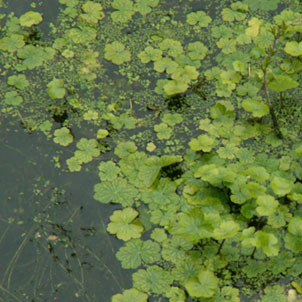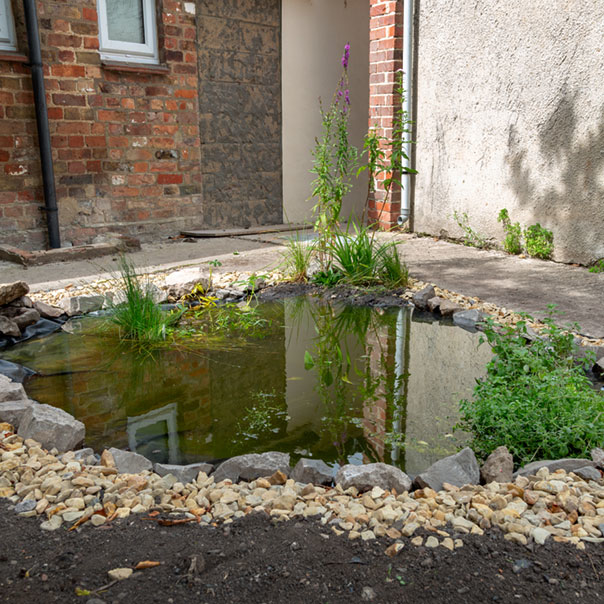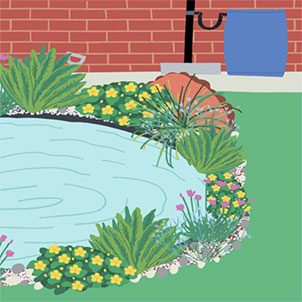A guide to native pond plants
Aquatic plants can bring amazing colour to your mini-wetland or pond and give a naturalistic feel. They can provide shelter for pond wildlife like water boatmen, tadpoles and other tiny creatures and also help to keep the water oxygenated and clean.
How much plant cover does a pond need?
You’ll want light to permeate down to the pond’s base to help submerged plants and animals to thrive. So a good rough rule of thumb is to ensure at least half the surface of the pond is free of foliage.
Different types of pond plants
There are four categories of plants for in and around ponds – which are handily separated into the four different places where they grow. Read our guide or watch the video for WWT’s recommendations for native pond plants.
Submerged or oxygenating pond plants
Fully submerged plants are also called oxygenating pond plants, because all their surfaces are underwater and capable of releasing oxygen into the water. This will help stop the pond becoming stagnant and smelly. Having oxygenating plants will reduce or remove any need for a pump system. They also provide great habitat for wildlife.
Floating pond plants
There are two types of floating plants:
- Plants that take root underwater – so you’ll need to put them in underwater pots like the submerged ones – but grow up to the surface where their leaves and flowers spread out. Waterlilies are a common example.
- Plants that simply float around on the surface with their roots bare to the open water rather than being grounded in soil or mud. A common example is frogbit. (A more common example you don’t want is duckweed which can cover your pond and cause water quality issues).
Marginal pond plants
So-called because they grow around the edge of ponds. They are also known as emergent pond plants because they are usually rooted in shallow water but emerge and grow vertically into the air like land-based plants. A good example is marsh marigold which you can plant in a semi-submerged pot.
Marsh plants
Also known as bog plants. These grown around your pond, just outside it, rather than in it. They are often interchangeable with Marginals – like the marsh marigold above which will also grow in damp soil around your pond, helping your pond blend in with its surroundings and also providing shelter for amphibians heading in and out of your pond. These plants are especially important if you set your pond up to receive rainwater and spill out into a bog garden.
Choosing aquatic plant pots and soil
Most planting is best left until late May when the danger of frost damage has passed and plants are at their most active.
Most garden centres will stock aquatic plant pots to put in your pond, which have meshed sides. This helps water – and tiny pond animals – to circulate around the roots. For marginals, you can also use the normal solid-sided pots as long as water can percolate up the holes in the base.
Use aquatic compost. This is heavier than garden compost which will help stop it simply floating away when you submerge the pot. Look for peat-free aquatic compost in order to help stop the world’s precious peatlands from being destroyed. You can also weigh pots down by putting stones or gravel on top.
Remember to use pots that are larger than the plant, so it will have space to grow into. You’ll need to take each pot out once a year to trim back the old plant growth as well as the roots from around the pot – so that each plant doesn’t simply keep expanding and take over the pond. Marsh plants can be put directly into the ground. While free-floating plants of course don’t need any planting at all!
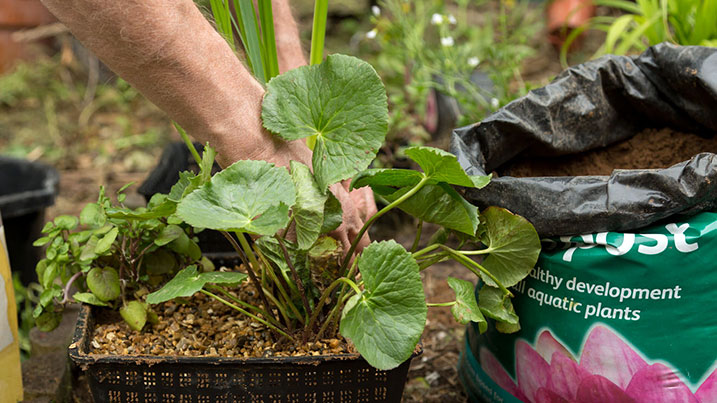
Choosing native pond plants
It’s always best to choose UK-grown native wetland varieties. Because of widespread wetland drainage, and the threat from non-native invasive species, many of our native wetland plants are struggling to survive.
By giving them a home in your garden and using them in your planting scheme for your pond, you’ll be providing vital help to protect these native varieties. There is more than enough variety and colour within our native flora to create the pond you want.
Attractive and useful native plants for garden ponds include:
Submerged oxygenating plants
- Spiked water-milfoil (Myriophyllum spicatum) - its attractive, feathery leaves are held just below the surface, but its tiny, reddish flowers emerge on spikes during June and July. Provides shelter for a range of aquatic wildlife and its emergent stems offer places for dragonflies and damselflies to lay their eggs.
- Rigid hornwort (Ceratophyllum demersum) - an excellent native oxygenator for small ponds. A great alternative to invasive non-native oxygenators like Canadian pondweed. Its fluffy, filamentous, bright-green leaves provide an excellent spawning habitat for fishes.
- Water violet (Hottonia palustris) - produces a delicate lilac and white tinged bloom above the surface of the water. It’s not actually a violet at all, but a member of the primrose family. They flower in May to June, and are loved by water beetles and nymphs alike.
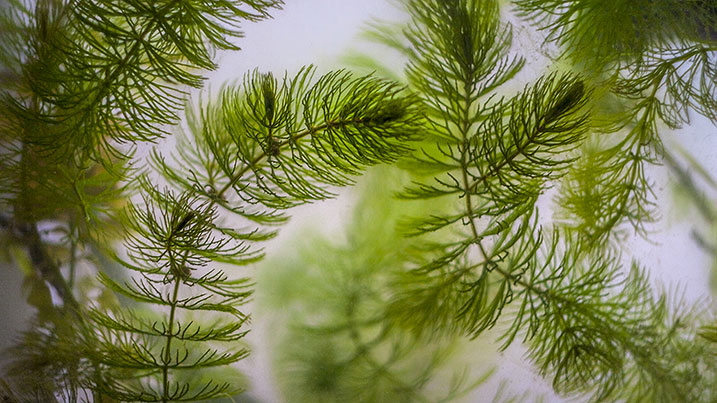
Floating pond plants
- A water lily (Nymphaeaceae, noting that the native species, Nymphaea alba can be too vigorous for use in a smaller pond) - possibly the most sought after of all water plants. With many shapes, sizes and colours to choose from, they are an excellent choice for any wetland garden, from an informal pond to a formal pool. They grow from submerged pots up to the surface where their leaves and flowers spread and float. Yellow and white flowering species are good for large ponds, and fringed is better for smaller. Provide shelter for frogs and early nectar insects.
- Common water-crowfoot (Ranunculus aquatalis) - this native oxygenating water plant is a member of the buttercup family. It displays white, buttercup-like flowers with yellow centres which provide food for bees, butterflies and other insects. Grows in free-floating mats in still or slow-moving water.
- Frogbit (Hydrocharis morsus-ranae) - the clue is in the name. It looks like a water lily as it free-floats on the surface of the water with rounds of leaves surrounding a white flower with a yellow centre. Tadpole, fish and dragonfly larvae like to hide under its leaves.
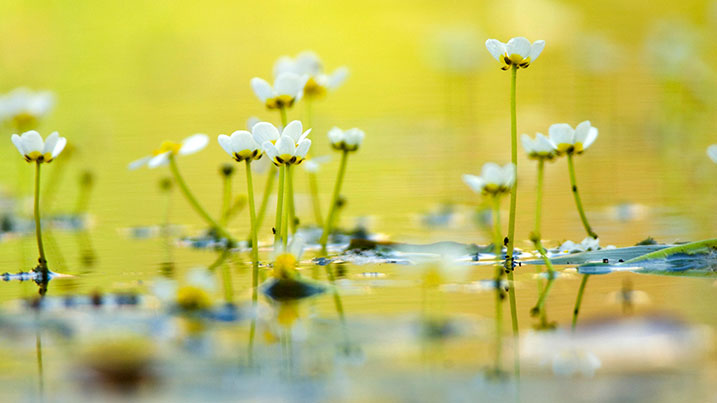
Marginal plants
- Water-forget-me-not (Myosotis scorpioides) - this marginal, shallow water plant produces clusters of sky-blue flowers in summer and is a favourite of traditional cottage gardens. Also known as “scorpion grass because of the curved ‘tail’ at the end of its stems. A favourite for newts to lay their eggs.
- Bogbean (Menyanthes trifoliata) - its starry white flowers can bring the green waters of any larger pond to life in spring. A valuable native plant that forms floating mats which provide egg laying sites for dragonfly, while the larvae use the stems to climb out of the water. Its leaves look like those of broad beans – hence the name.
- Watermint (Mentha aquatica) - flowers from July to October. Its leaves can be used to flavour food and drink. Attractive to a variety of insects, including small tortoiseshell, peacock and comma butterflies, as well as the green tortoise beetle.
- Yellow Flag Iris (Iris pseudacorus) - the big, showy giant of UK marginals. It can grow up to 1.5 metres tall so watch it doesn’t over-tip itself and fall over. The large yellow flowers have an outer ring of three large petals which droop characteristically. The whole plant is a multi-storey home for many species. Emerging froglets love to hid among its rhizome root system.
- Lesser Spearwort (Ranunculus flammula) - this plant is a common sight at the edges of ponds and other freshwater bodies, and great for a small pond. It looks a bit like a spindly buttercup, with sunshine yellow flowers. However, instead of divided round leaves these are pointed like a spear – hence the name. Handle this plant with care as the sap can irritate sensitive skin.
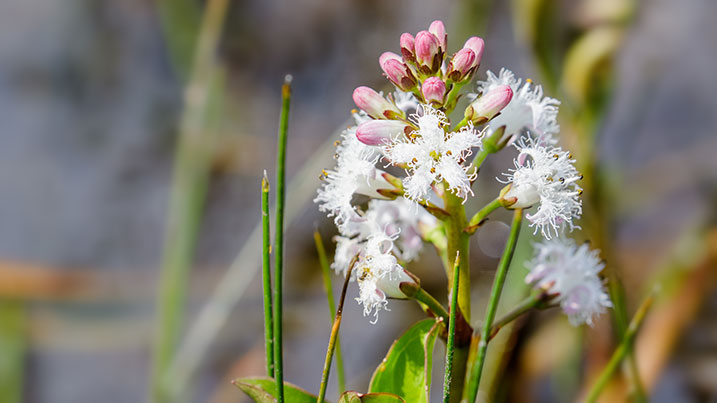
Marsh plants
- Marsh marigold (Caltha palustris) - this early flowering plant is an excellent marginal providing an early source of pollen for bees and hover flies. Also known as “kingcups” this stout yellow wildflower could be one of our most ancient plants, thought to have been growing here since before the last Ice Age.
- Globeflower (Trollius europillworaeus) - toes best at pond margins where it makes a later blooming alternative to marsh marigolds. It is a large member of the buttercup family. Once widespread, it is now in decline because of grazing pressures on the damp meadows it likes.
- Pillwort (Pilularia globulifera) - the UK’s only aquatic fern. Given the right conditions it can form a creeping mat over bare mud at the margins of ponds giving the impression of a miniature bright green lawn. It’s in decline across the UK so why not give it a helping hand by adding it to your wetland garden.
- Brooklime (Veronica beccabunga) - Brooklime is a later bloomer (May till September.) Its flowers are a pretty blue and it will be in leaf all year round. It likes the margins of running fresh water and thrives in damp soil. It makes great cover for tadpoles in small ponds and is easy to control.
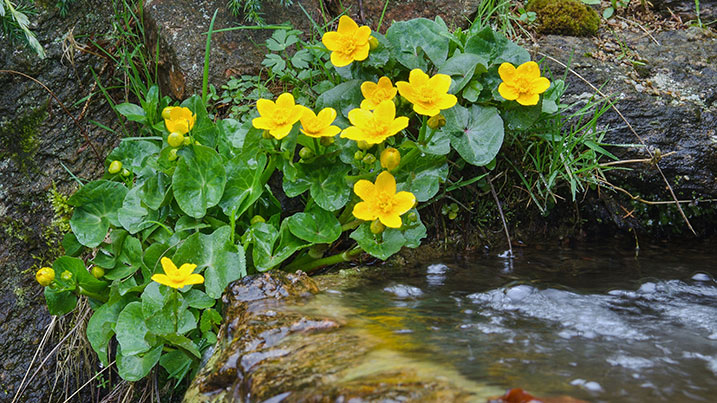
For more ideas, visit a specialist garden centre, consult online plant catalogues and visit your local WWT centre to see what we’re doing. The best native plants for ponds will, to an extent, be dependent on where you live, so visiting your local suppliers with this guide is your best move.
Invasive species - what not to choose
There are many foreign plants available that can prove irresistible. If you do buy or already have some of these plants, do be aware that several of these species like to spread, squeezing out other species and upsetting the pond’s balance.
Find out more about why invasive species a problem.
Here are the worst offenders (in the UK) to be aware of
- Parrot’s feather (Myriophyllum aquaticum) or Brazilian Water-milfoil
- Water fern (Azolla filiculoides) or Fairy Fern
- Water primrose (Ludwigia grandiflora)
- Floating pennywort (Hydrocotyle ranunculoides)
- New Zealand pygmyweed (Crassula helmsii)
- Himalayan balsam (Impatiens glandulifera) or Indian balsam
- American skunk cabbage (Lysichiton americanus)
- Common water hyacinth (Eichhornia crassipes)
- Cabomba (Cambomba Caroliniana)
- Broadleaf water milfoil (Myriophyllum heterophyllum)
- Duck potato (Sagittaria latifolia)
- Water lettuce (Pistia stratiotes)
- Giant rhubarb (Gunnera species)
